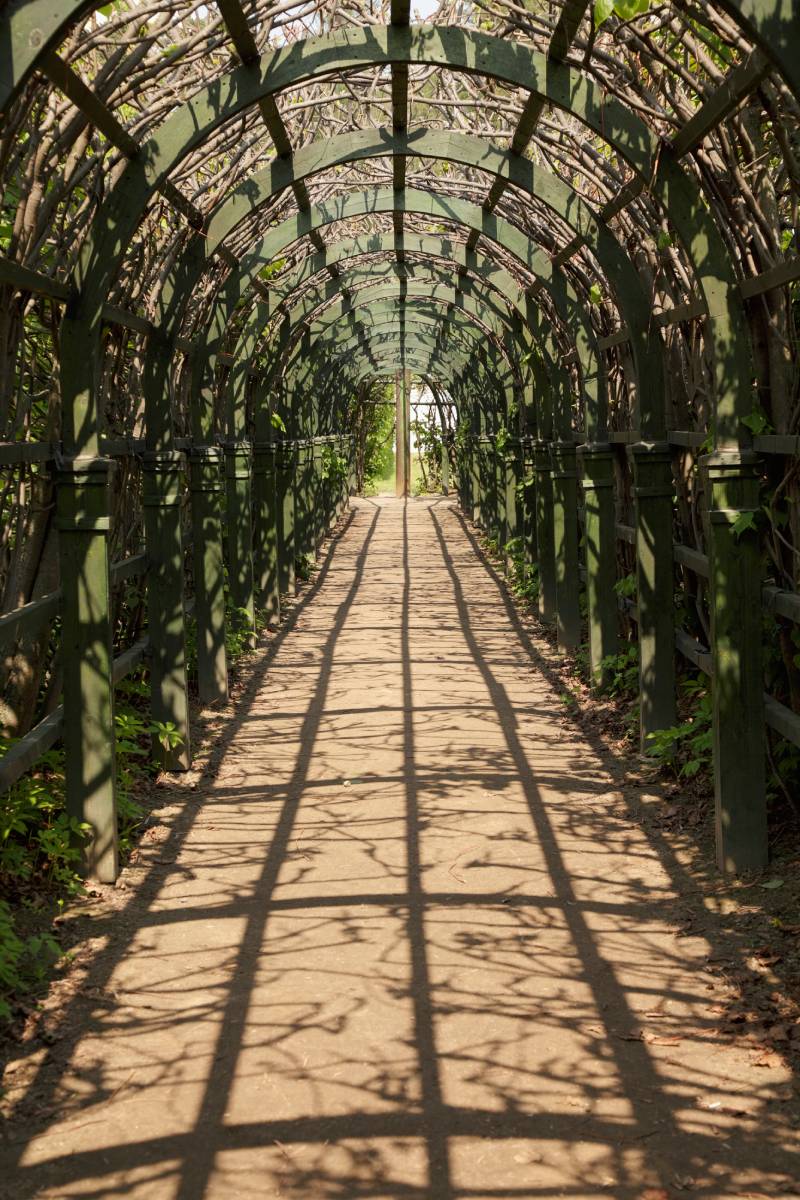How do you set up a garden arch? What plants are best for a garden arch? How high should a garden arch be?
Culture, House & Garden, LifeStyle Dec 20, 2023

Creating a picturesque garden space involves thoughtful decisions, and one key element that adds both beauty and functionality is the garden arch. Whether you’re envisioning a charming passage, a focal point, or a decorative structure adorned with climbing plants, the height of your garden arch plays a crucial role in achieving the desired aesthetic.
In this exploration, we’ll delve into considerations for choosing the perfect height for your garden arch, from scale and purpose to personal preferences and practical aspects.
A garden arch is one of the great home elevations that creates a beautiful perspective and can add a touch of charm and elegance to your outdoor space. Setting up a garden arch may seem like a daunting task, but with a few simple steps, you can transform your garden into a picturesque haven. Let’s break down the process into easy-to-follow instructions.
1. Choose the Right Location: Start by selecting the ideal spot for your garden arch. Consider the layout of your garden and choose a location that complements the overall design. Ensure that the ground is level, as this will make the installation process smoother.
2. Gather Your Tools and Materials: To set up a garden arch, you’ll need some basic tools and materials. Gather items such as a shovel, a level, stakes, string, a rubber mallet, and, of course, your garden arch kit. Most garden arch kits come with all the necessary components, including arch segments and hardware.
3. Mark the Placement: Use stakes and string to mark the exact placement of your garden arch. This will help you visualize the positioning and ensure accuracy during installation. Use the level to make sure the ground is even and adjust as needed.
4. Prepare the Soil: Before assembling the garden arch, it’s essential to prepare the soil where the legs will be inserted. Use the shovel to dig holes for the arch legs, making sure they are deep enough for stability. Loosen the soil to make it easier to insert the legs.
5. Assemble the Arch: Follow the manufacturer’s instructions to assemble the garden arch. Typically, this involves connecting the arch segments and securing them with the provided hardware. Use the rubber mallet to gently tap the pieces together, ensuring a snug fit.
6. Install the Garden Arch: With the arch assembled, carefully lift it and place the legs into the prepared holes. Double-check the level to ensure that the arch is standing straight. Once in position, backfill the holes with soil and press it down firmly to secure the arch in place.
7. Optional: Add Climbing Plants: To enhance the beauty of your garden arch, consider planting climbing plants at the base. These plants will eventually weave through the arch, creating a stunning natural canopy. Popular choices include roses, clematis, and wisteria.
8. Maintain and Enjoy: Regularly check the stability of your garden arch, especially during extreme weather conditions. Inspect for any signs of wear or damage and address them promptly. As your climbing plants grow, prune them as needed to maintain the desired shape and appearance of the arch.
Setting up a garden arch is a straightforward process that can greatly enhance the aesthetic appeal of your garden. By carefully choosing the location, assembling the arch with precision, and adding climbing plants for that extra flourish, you’ll create a delightful focal point in your outdoor space. Enjoy the beauty of your garden arch as it becomes a charming gateway to nature in your own backyard.

What plants are best for a garden arch?
Creating a stunning garden arch involves choosing the right plants to adorn it, adding a touch of natural beauty and charm to your outdoor space. When selecting plants for a garden arch, consider factors such as climate, sunlight, and personal preferences. Let’s explore some popular and easy-to-care-for plants that are well-suited for adorning your garden arch.
Roses
Roses are classic and timeless choices for a garden arch. They come in various colours and varieties, offering versatility to suit your garden’s theme. Climbing roses, in particular, gracefully weave through the arch, creating a romantic and fragrant atmosphere. Ensure they receive ample sunlight for optimal blooming.
Clematis
Known for their vibrant and showy flowers, clematis vines are excellent for climbing structures like garden arches. They come in a range of colours and bloom times, providing seasonal interest. Clematis prefers well-draining soil and benefit from having their roots shaded, making them an ideal companion for arches.
Wisteria
Wisteria is renowned for its cascading clusters of flowers that drape elegantly over garden structures. The long, pendulous blooms create a picturesque display. Choose a sturdy garden arch, as wisteria vines can become heavy as they mature. Provide full sun and regular pruning to maintain a well-shaped arch.
Jasmine
Jasmine vines add a touch of sweetness to your garden arch with their fragrant white or yellow blossoms. These fast-growing vines are relatively low-maintenance and thrive in full to partial sunlight. Jasmine’s aromatic flowers make it a delightful choice for creating a sensory-rich garden experience.
Honeysuckle
Honeysuckle vines are not only attractive but also attract pollinators with their sweet-scented, tubular flowers. Choose a sunny location for your garden arch and watch as honeysuckle vines gracefully twine around it. Regular pruning helps control their growth and promotes a lush appearance.
Morning Glory
For a burst of colour, consider planting morning glory vines. These fast-growing annuals produce vibrant, trumpet-shaped flowers in various hues. Morning glory vines are easy to grow from seed and thrive in full sunlight. They add a cheerful and whimsical element to your garden arch.
Passionflower
Passionflowers are unique and exotic climbers that feature intricate, multi-coloured blooms. Beyond their stunning appearance, passionflowers attract butterflies and other pollinators. Plant them in well-drained soil and provide support for the vines to climb and bloom beautifully over the garden arch.
Trumpet Vine
Trumpet vines, also known as Campsis or Trumpet Creeper, showcase bright orange or red trumpet-shaped flowers. These vigorous climbers thrive in full sun and well-drained soil. Trumpet vines are hardy and resilient, making them suitable for garden arches where you desire a burst of colour and a touch of drama.

How high should a garden arch be?
Selecting the appropriate height for a garden arch is crucial to achieving a balanced and aesthetically pleasing look in your outdoor space. The height of your garden arch depends on various factors, including the arch’s purpose, the surrounding landscape, and personal preferences. Let’s explore some considerations to help you determine the ideal height for your garden arch.
1. Consider the Scale: One of the primary considerations when deciding on the height of your garden arch is the scale of your garden and its surroundings. A tall garden arch in a small yard may overpower the space, while a short arch in a large garden might get lost. Aim for a height that complements the overall size and layout of your outdoor area.
2. Passage or Focal Point: Determine the intended function of your garden arch. If it serves as a passage or entrance, consider a height that allows easy passage without feeling cramped. For arches designed as focal points or decorative elements, you have more flexibility in choosing a height that enhances the visual impact.
3. Architectural Style: Take cues from the architectural style of your home and garden. A formal garden or a home with classic architecture may benefit from a taller and more structured arch, while a cottage garden or a more informal setting might suit a shorter and whimsical design.
4. Plant Considerations: Think about the types of plants you plan to grow on the arch. Some climbing plants, like wisteria or roses, may have vigorous growth and require a taller structure to accommodate their natural habits. Smaller or more delicate vines might flourish on a shorter arch.
5. Visual Harmony: Achieving visual harmony in your garden is essential. Your garden arch should seamlessly blend with the surrounding elements. A well-proportioned arch contributes to the overall balance of the garden, enhancing its visual appeal.
6. Personal Preference: Ultimately, your personal preferences play a significant role in determining the height of your garden arch. Consider the visual impact you want to create and the atmosphere you aim to achieve in your outdoor space. Whether you prefer a more intimate, cosy feel or an open and grand ambience, your preferences should guide your decision.
7. Practical Considerations: Practical considerations, such as the height of nearby structures, trees, or fences, also come into play. Ensure that the chosen height allows for proper clearance and doesn’t obstruct views or create awkward spatial relationships within your garden.
8. Standard Heights: While there are no strict rules for garden arch heights, some standard measurements can provide a starting point. Common heights range from 2 – 2.5 metres for arches used as entrances or focal points. Smaller arches, used in more confined spaces or for ornamental purposes, may range from 1.2 to 1.6 metres.